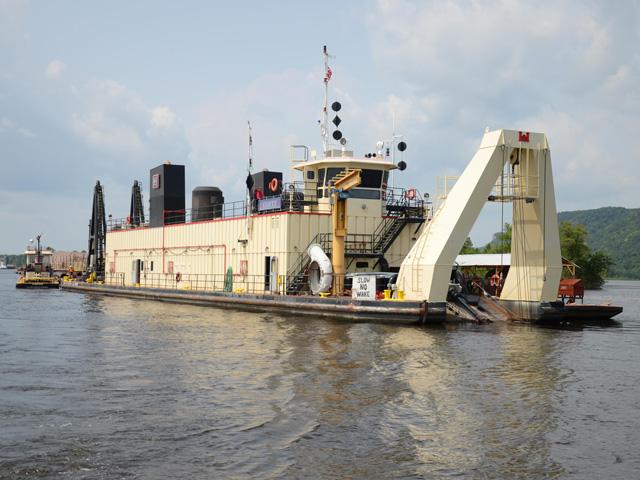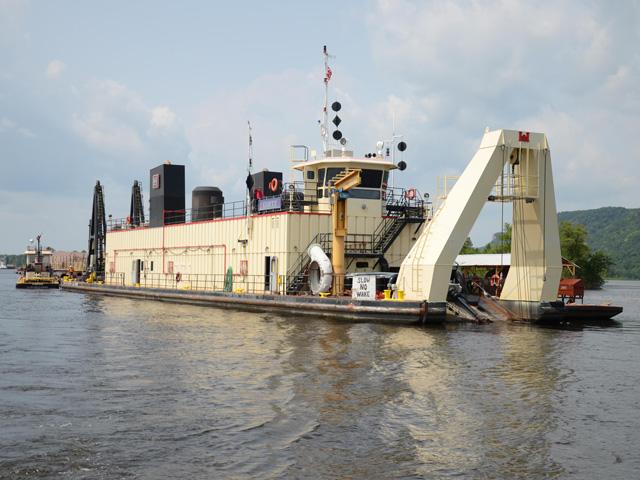Market Matters Blog
Dredges Keep US River System Safe, Reliable
Think back to last fall when water levels fell to historical lows in some spots and caused an uproar in barge shipments in the Lower Mississippi River. Dredges came to the rescue to keep the channels open as much as possible and spent six months doing so, dredging almost 3 1/2 months longer than normal, according to the U.S. Army Corps of Engineers.
"The Dredge Potter crew finished up an unprecedented 2022-23 season on Feb. 1, 2023, that required tremendous teamwork to maintain the congressionally mandated 9-foot-deep, 300-foot-wide navigation channel and overcome the challenges from the widespread drought and prolonged extreme low water that affected the Mississippi River basin," said USACE St. Louis District on its website.
Dredging operations moved 9 million cubic yards of material, at 70 different locations along 300 miles of the St. Louis District. In total, seven dredging units -- dustpan, cutterhead and mechanical -- worked throughout the St. Louis District area of responsibility. Two other units, for a total of nine, supported Mississippi Valley Division efforts on the Mississippi River.
"Normally, an average year results in 3 million to 4 million cubic yards of material being moved in the St. Louis District by two dredges. In anticipation of the drought, St. Louis District Dredging Program Manager Lance Engle implemented advanced measures -- bringing in additional assets ahead of the forecasted lows -- to maintain the congressionally authorized channel.
"As the extreme low water persisted month-after-month, closely monitored surveys were consistently reviewed in conjunction with the forecast and input from industry to determine the order and coordination of work and additional assets needed. The ability of the team to present a common operating picture through meetings, phone calls and the Navigation Conditions Status Report enabled the safe planning and shipment of waterborne commerce in support of the nation's economy," added USACE.
P[L1] D[0x0] M[300x250] OOP[F] ADUNIT[] T[]
"For reference, it would take more than 2,700 Olympic-size swimming pools to contain the 9 million cubic yards of dredge material removed from the riverbed this year, compared with just 1,000 Olympic-size swimming pools in a normal season."
The USACE maintains a 9-foot-deep channel down the Mississippi River, so that ships and barges can travel safely downriver. In the Upper Mississippi River, the lock and dam system actually makes the river "drought proof" unlike the Lower Mississippi River where low water can wreak havoc with barges trying to get to the Gulf as we saw in 2022.
However, when the Upper Mississippi River experiences flooding as it did this past spring, a complete river closure becomes necessary when the water covers the lock chamber and also when the current is too strong to keep barges from getting too close to the dams.
The Corps operates those locks and dams on the Mississippi River for navigation, not flood control. The locks and dams create "slack-water pools for navigation during periods of low and moderate level water. For each pool, there is a primary control point, where a predetermined water elevation must be kept for navigation to continue," the Corps' website noted.
Flooding causes sand and silt to be carried throughout the river due to stronger currents and faster movement of the water. This is also known as "shoaling" and the sandbars it creates cause dangerous conditions for barges moving up and down the river through the channels.
The process of sediment removal is called "dredging" and is performed by a floating plant known as a dredger or dredge. A dredging schedule can be found on each USACE District website. The schedule by equipment includes information about where (by river mile) and what date(s) the dredging will occur. It also includes what depth and estimated quantities will be, where dredged material will be taken, and what piece of dredging equipment will be used.
Here is a link to the St. Paul District dredge schedule, which has been very busy so far this summer on the Mississippi River after strong spring flooding. Dredging has also taken place on the Minnesota River that meets the Mississippi upriver from downtown St. Paul. https://www.mvp.usace.army.mil/…
Here is a fact sheet about beneficial use of dredged material: https://dredging.org/…
Mary Kennedy can be reached at mary.kennedy@dtn.com
Follow her on X, formerly known as Twitter, @MaryCKenn
(c) Copyright 2023 DTN, LLC. All rights reserved.






Comments
To comment, please Log In or Join our Community .